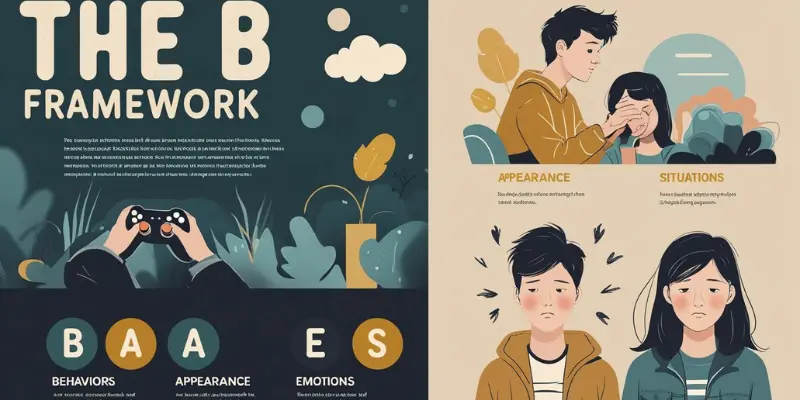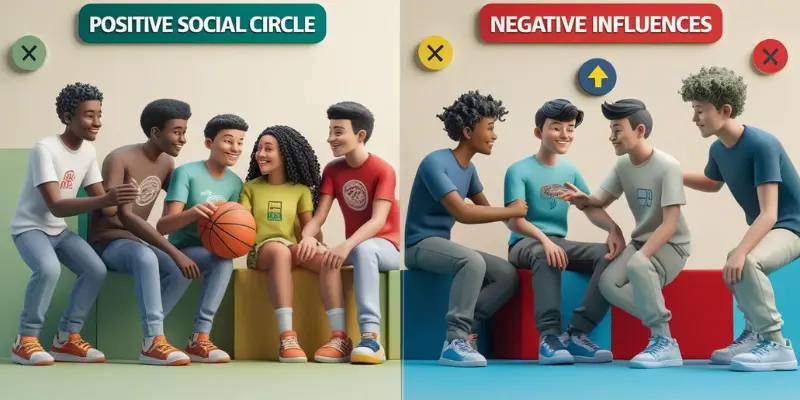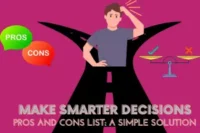15 Red Flags in Teenage Behavior: A Parent’s Checklist for What to Do Next
Published: 21/08/2025
As a parent, it’s only natural to feel concerned when your teenager begins to change in ways that seem confusing, unsettling, or even alarming. You may wonder, Is this just a phase that all teens go through, or is there something more to it? Navigating your teen’s behavior can feel like walking a tightrope. On one hand, you want to give them the space they need to grow and develop independence. On the other hand, you fear that some of their actions might signal deeper issues that require your attention.
You’re not alone in this struggle. Many parents feel uncertain about where to draw the line between normal teenage behavior and potential red flags. Is the moodiness a result of hormonal changes, or is it a sign of something more serious like depression? Does their sudden desire for privacy mean they’re just growing up, or are they pulling away from a difficult situation?
This dilemma is exactly why you’re here, searching for answers. Understanding the difference between normal teenage behavior and concerning signs can be one of the most difficult parts of parenting. It’s overwhelming, and sometimes, it’s hard to know where to start.
In this guide, we’ve put together a clear, actionable checklist to help you confidently identify the warning signs that may indicate your teen needs more support. By the end, you’ll feel equipped to make informed decisions and know exactly what steps to take next. The goal isn’t just to point out problems but to empower you with the tools you need to navigate this challenging period with compassion and clarity.
What’s Normal vs. What’s a Red Flag?
Adolescence is a time of profound change—physically, emotionally, and socially. It’s a period where your teen’s brain is still developing, and with this growth comes a variety of behaviors that may seem confusing or even concerning. It’s important to remember that many of the changes teens go through are a normal part of their development. Defiance, mood swings, and a desire for more privacy are all typical teenage experiences, often tied to hormonal shifts and the brain’s maturation process.
That said, distinguishing between what’s normal and what’s a red flag can be tricky. So, how can you tell the difference? How do you know when a behavior is simply part of growing up, and when it’s something more serious?
The “Two-Week” Rule
One expert-backed approach to help you make this distinction is the “Two-Week Rule”. According to this rule, a behavior becomes a red flag when it lasts for more than two weeks, is particularly intense, and starts to negatively affect your teen’s daily life.
For example, if your teen’s mood swings are lasting for days on end and they’re impacting their school performance, relationships, or overall well-being, it could indicate something beyond the normal ups and downs of adolescence. Likewise, a sudden drop in interest in activities they once enjoyed, paired with social isolation, may be a sign of depression rather than a typical teenage phase.
By using the Two-Week Rule, you create a simple metric to guide your observations and help you decide when to seek help or take action.
The BAES Framework
To further help you identify red flags and organize your observations, we introduce the BAES Framework. This powerful acronym stands for Behaviors, Appearance, Emotions, and Situations. By focusing on these four key areas, you can get a clearer picture of your teen’s behavior and whether it’s truly concerning.
- Behaviors: Are your teen’s actions out of the ordinary? Are they engaging in risky behavior, such as substance use, reckless driving, or even aggression? These could indicate deeper emotional or psychological issues.
- Appearance: Physical signs are often some of the first indicators that something’s wrong. Has your teen suddenly stopped grooming themselves or neglected their hygiene? A significant change in appearance can signal depression, anxiety, or other struggles.
- Emotions: Pay attention to emotional shifts that go beyond typical teenage moodiness. Are they exhibiting extreme sadness, anger, or anxiety that seems uncharacteristic or persistent? Extreme emotional swings can be a red flag.
- Situations: Examine changes in the social dynamics and environment around your teen. Are they withdrawing from friends or getting involved in risky groups or situations? Dramatic changes in social circles or risky situations are often a sign that something more is going on beneath the surface.

By keeping the BAES Framework in mind, you can more easily identify patterns and decide if your teen’s behavior is something that warrants concern. These tools—combined with the Two-Week Rule—give you a structured way to evaluate your teen’s behavior and determine if it’s a normal part of adolescence or a red flag requiring intervention.
15 Red Flags in Teenage Behavior: Your Checklist
This checklist is designed to help you identify potential red flags in your teen’s behavior. Keep in mind, a single sign may not always be a cause for alarm, but when behaviors persist or escalate, it’s essential to take action. Below are 15 key red flags that should not be ignored.
B: Behaviors
As a parent, it’s important to recognize that adolescence is a time of change. While it’s normal for teens to seek more independence, there’s a fine line between normal teenage behavior and a deeper issue. Pay attention to patterns—subtle shifts in how your teen interacts with family and friends can often be the first signs of something more concerning. Understanding the difference between normal mood swings and more serious changes in behavior can help you take timely action.
Sudden Social Isolation
Teens naturally seek privacy as they grow, but there’s a big difference between wanting alone time and withdrawing entirely from friends and family. If your teen stops engaging in social activities, isolates themselves in their room for long periods, or cuts off communication with close friends, this could indicate something more serious, like depression or anxiety.
Example: Instead of just staying in on a Friday night, your teen might refuse all attempts to connect, even avoiding family interactions. This shift can signal emotional or psychological distress.
Unexplained Academic Decline
A sudden and significant drop in grades or a lack of interest in school can be a red flag. While some teens may experience academic struggles due to workload or personal challenges, a sharp decline may indicate that they’re dealing with deeper issues, such as depression, stress, or difficulty focusing.
Example: Your teen, who once enjoyed school, may start skipping classes, turning in incomplete assignments, or refusing to talk about their school day. This could be a sign that something is troubling them.
Engaging in Impulsive or Risky Behavior
Teens may take risks as part of normal exploration, but if they are engaging in risky behaviors such as substance use, reckless driving, or illegal activities, it’s time to be concerned. These behaviors may be linked to trying to cope with emotional pain or peer pressure.
Example: Your teen might start hanging out with new friends who encourage risky behavior like skipping school, experimenting with alcohol or drugs, or engaging in dangerous stunts.
Aggressive and Violent Outbursts
While it’s normal for teens to feel frustration, it crosses a line when frustration turns into aggressive outbursts—especially if these involve breaking things, physical violence, or intense verbal abuse. If anger seems uncontrollable, it’s a major red flag for potential emotional or behavioral issues.
Example: What might begin as mild irritation could escalate to shouting matches, throwing objects, or even physical fights. If these outbursts are becoming frequent, professional support might be necessary.
Unusual Changes in Sleep or Eating Patterns
Teens often experience changes in their sleep and eating habits, but major shifts—such as sleeping excessively or hardly at all, or significant weight loss or gain—can be signs of underlying health issues, such as depression or eating disorders.
Example: If your teen begins sleeping 12+ hours a day and struggles to get up for school, or conversely, if they suddenly can’t fall asleep and are staying up all night, this should raise concerns. Similarly, a sudden change in eating habits, like refusing to eat or eating excessively, could signal an issue.
Consider a common scenario: “Your teen used to enjoy hanging out with friends every weekend, but recently, they’ve opted to stay in their room, avoiding even family gatherings. It’s no longer just about privacy; it’s complete isolation.”
Keep a close eye on these behaviors and their duration. If any of these red flags seem to persist or worsen, it may be time to seek professional guidance to understand the underlying causes and support your teen’s well-being.
A: Appearance
Teens go through many changes, and their appearance might reflect some of those shifts. While it’s normal for them to experiment with their style or sometimes neglect grooming, a sudden and dramatic change in how they care for themselves can be a cause for concern. Keep an eye on whether these changes are part of a temporary phase or a sign of something deeper that needs attention.
Neglect of Personal Hygiene
A sudden disinterest in personal grooming and self-care is often one of the first signs that something may be wrong. While teens can be messy or rebellious about their appearance at times, a significant and sudden decline in hygiene—such as not showering, neglecting basic grooming, or wearing dirty clothes for extended periods—can indicate depression or other emotional distress.
Example: If your teen, who once took care in their appearance, begins to avoid showers, change clothes infrequently, or stop brushing their hair or teeth, it may suggest they’re struggling with mental health challenges.
Self-Harm
Self-harm, including cuts, burns, or other visible signs of self-inflicted harm, is a serious and alarming red flag. It’s often a way for teens to cope with overwhelming emotions, such as anger, sadness, or anxiety. While not all teens who self-harm will show visible signs, any indication of this behavior—whether through physical wounds or other signs like wearing long sleeves in warm weather—should be addressed immediately.
Example: Your teen may start to wear long-sleeved clothing or make excuses to avoid swimming or gym class, revealing cuts, burns, or scars on their arms or legs. This should prompt an immediate conversation and potential intervention.
E: Emotions
During adolescence, emotional shifts are common as teens navigate complex changes. However, when these emotional ups and downs start to feel more intense or disruptive, they can signal deeper emotional challenges. It’s essential to observe whether these mood fluctuations are part of the normal growing pains or something more persistent that may need attention.
Extreme or Pervasive Mood Swings
Mood swings are a natural part of adolescence due to hormonal changes. However, when these mood swings go beyond typical irritability and become persistent feelings of sadness, anger, or anxiety, it may indicate a deeper emotional struggle. Teens who experience extreme mood swings may become intensely upset over small issues, or they may fluctuate rapidly between happiness and despair.
Example: If your teen’s mood shifts seem unpredictable—one minute laughing, the next crying uncontrollably—and these emotional ups and downs seem out of character, this could signal depression or anxiety.
Hopelessness or Despair
Teens are known for being dramatic at times, but a lack of interest in former hobbies, along with a pessimistic outlook on life, is a serious red flag. If your teen no longer seems to care about things they once loved—whether it’s playing sports, hanging out with friends, or engaging in creative activities—this can point to feelings of hopelessness and deep emotional pain.
Example: Your teen may express statements like, “What’s the point of anything?” or “I don’t care about anything anymore.” This withdrawal from interests and a pervasive sense of despair can be linked to depression.
Excessive Worry or Paranoia
Excessive worry or paranoia that disrupts daily life can be a sign of an anxiety disorder or other mental health issue. While it’s normal for teens to worry about school, friends, or the future, constant anxiety or irrational fears can lead to overwhelming stress that affects their daily functioning.
Example: If your teen seems constantly anxious, avoids social situations due to fear, or expresses irrational worries (like fearing that people are talking about them or planning harm), it’s important to address the root cause of their anxiety.
Overly High or Low Self-Esteem
A sudden shift in self-esteem—either extreme feelings of worthlessness or an inflated sense of grandiosity—can be a warning sign of emotional or psychological issues. Teens with low self-esteem may become withdrawn, excessively self-critical, and feel they’re unworthy of love or respect. On the other hand, a sudden increase in self-importance, where your teen believes they’re superior to others or invincible, may signal underlying issues such as depression or early signs of personality disorders.
Example: Your teen might constantly say things like, “I’m worthless” or “No one cares about me,” showing signs of low self-esteem. Alternatively, they might express unrealistic grandiosity, like believing they are destined for greatness, even to the point of dismissing others.
S: Situations
As teens grow, their social circles naturally evolve. They may begin to spend more time with different groups, trying to fit in or find a sense of belonging. However, it’s important to watch for signs when these changes shift in a concerning direction, such as associating with negative influences. Pay attention to the type of people your teen is gravitating toward, as this can provide insight into their emotional well-being.
Drastic Change in Social Circles
A dramatic shift in social circles can be a red flag, especially if your teen begins abandoning old, positive friendships for new, negative influences. It’s natural for teens to outgrow certain friendships, but if they start hanging around with peers who encourage risky behavior, such as substance abuse or bullying, it can signal that they are trying to escape from something they’re struggling with.
Example: Your teen, who once had a close-knit group of friends, may suddenly start associating with a different crowd that engages in unhealthy behaviors or introduces them to negative influences.

Running Away from Home
When a teen’s anger, sadness, or emotional distress leads them to try to escape by running away from home, it’s a clear red flag that their emotional state is fragile. Running away is often a sign of feeling hopeless or overwhelmed, and while some teens might temporarily leave in moments of frustration, a pattern of running away is a major concern.
Example: If your teen has threatened to run away or has gone missing for even a short time, it’s a signal that they may be in emotional turmoil that requires immediate attention.
Threats of Suicide
Threats of suicide or self-harm should always be taken seriously. These are urgent red flags that demand immediate action. It’s normal to feel overwhelmed or unsure about how to respond, but ignoring such threats can have tragic consequences. If your teen expresses suicidal thoughts—whether directly or indirectly—don’t hesitate to seek professional help right away.
Example: Statements like “I wish I were dead,” “Everyone would be better off without me,” or “I don’t want to live anymore” should be treated as immediate emergencies. Reach out to a mental health professional, or contact a helpline for immediate support.
Recognizing these signs can be incredibly challenging, but the earlier you identify them, the sooner you can intervene and offer the help your teen needs. If any of these behaviors seem familiar, it’s crucial to seek professional guidance to better understand what your teen is going through and how to best support them.
Your Action Plan: What to Do Next
Now that you’ve identified potential red flags in your teen’s behavior, the next step is to take action. As a parent, it’s understandable that you may feel overwhelmed, unsure of how to approach your teen, or even afraid of making the situation worse. However, how you respond can make all the difference in your teen’s journey toward healing and growth. Below are expert tips and actionable guidance to help you navigate this challenging situation with care and confidence.
How to Talk to Your Teen
When it comes to communicating with your teen, the way you approach the conversation is just as important as what you say. Teens often shut down when they feel criticized or judged, so it’s essential to create an open, safe space for them to express their feelings. By shifting the focus to understanding their perspective, you’ll be more likely to have a meaningful, productive conversation.
Listen, Don’t Lecture
It’s natural to want to fix things immediately or share your wisdom, but one of the most powerful things you can do is simply listen. Your teen may be feeling isolated, unheard, or misunderstood. Let them express themselves fully without interrupting or offering solutions right away. Active listening shows that you value their perspective, which can build trust and open the door for future conversations.
Tip: Let them speak without judgment or interruption. Instead of saying, “You shouldn’t be feeling this way,” try responding with, “I’m really sorry you’re feeling this way. Can you tell me more about what’s going on?”
Find Common Ground
Opening the conversation can sometimes feel like a daunting task, especially if your teen is withdrawn or unwilling to engage. One helpful approach is to focus on a shared interest or activity to break the ice. Whether it’s a hobby, a favorite show, or something they’re passionate about, this can help create a sense of connection and ease the tension.
Tip: Start by asking, “Have you seen the latest episode of [insert TV show]?” or “I know you’ve been interested in [insert hobby] lately. Can we talk about that?” It’s a non-threatening way to begin a deeper conversation.
The Power of “I” Statements
When discussing sensitive topics, how you say things matters just as much as what you say. Using “I” statements can help express your concerns without making your teen feel attacked. For instance, rather than saying, “You never talk to me,” you can say, “I feel worried when you don’t open up about what’s going on.” This approach allows you to express your feelings while still focusing on their behavior, not their character.

Tip: Replace accusatory language with personal feelings. For example, instead of, “You’re always so angry,” say, “I’ve noticed that you seem really upset lately, and it worries me.”
Common Mistakes to Avoid
When trying to support your teen, it’s easy to fall into the trap of minimizing their emotions. You might feel that you’re trying to help by telling them to move on, but this can actually have the opposite effect. Instead of offering immediate solutions, it’s important to recognize the significance of what they’re going through, even if it seems trivial to you. This small shift in approach can make a big difference in how your teen responds.
Don’t Dismiss Their Feelings
It’s tempting to brush off your teen’s emotions or try to make them “snap out of it,” especially if the behavior seems minor or unimportant. However, dismissing their feelings can lead to more isolation, as they may feel invalidated or misunderstood. Phrases like, “It’s not a big deal,” or “Just get over it,” can alienate your teen and make them feel like their struggles aren’t taken seriously.
Tip: Instead of dismissing their emotions, acknowledge them. For example, say, “I understand that you’re going through something tough right now,” or “It sounds like you’re feeling really overwhelmed.”
Don’t Blame Yourself
If you’ve noticed concerning behavior in your teen, it’s easy to fall into the trap of blaming yourself. You might wonder if something you did (or didn’t do) led to their current struggles. But the truth is, adolescence is a challenging time filled with both external and internal pressures that are often out of your control. Be kind to yourself and remember that this is not a sign of failure as a parent.
Tip: Focus on what you can control—your response, your support, and your willingness to help. Don’t get stuck in guilt; instead, empower yourself to take positive action.
Don’t Wait for the Behavior to Go Away
One of the biggest mistakes parents make is waiting for the behavior to resolve itself. Sometimes, teens will “grow out of” certain behaviors, but other times, their struggles will worsen if not addressed early. The earlier you act, the more likely it is that you can help your teen before things escalate further.
Tip: If you’ve noticed persistent or intense behaviors (lasting for two weeks or more), don’t wait for it to pass. Initiate the conversation, seek professional help if needed, and take proactive steps to provide support.
Taking action doesn’t mean you need to have all the answers right away. What’s most important is that you show your teen they’re not alone in their struggles. By listening with empathy, responding thoughtfully, and offering your support, you can make a meaningful difference in their journey toward healing. Be patient, but also proactive—every small step you take will bring you closer to understanding and helping your teen through this difficult time.
When and How to Seek Professional Help
As a parent, it can be difficult to know when to seek professional help for your teen. It’s natural to want to handle things on your own, especially when it feels like a phase that might pass. However, when the signs are persistent and overwhelming, seeking professional help can make all the difference. Early intervention is crucial for addressing your teen’s challenges before they become more ingrained, and it can significantly improve their emotional well-being and long-term development.
Why Early Intervention is a Game Changer
The earlier you seek professional help for your teen, the better their chances are of developing healthy coping mechanisms and finding lasting solutions to their struggles. Early intervention doesn’t just help manage symptoms—it addresses the root causes of behavioral and emotional issues, preventing them from spiraling further. By intervening early, you give your teen the tools they need to navigate difficult emotions, build resilience, and adapt in positive ways.
Studies show that when teens receive the right support during the critical stages of adolescence, they are better equipped to handle life’s challenges and make healthier decisions in the future. In contrast, ignoring or downplaying concerning behaviors can lead to worsening mental health issues, such as anxiety, depression, and substance abuse, which can persist into adulthood.
Example: A teen who struggles with anxiety and is offered therapy early on is far more likely to learn coping strategies and reduce the severity of their symptoms. Without intervention, the same teen may face increasingly debilitating anxiety that affects their social life, academics, and even physical health.
Understanding Your Options
If you’re considering professional help, there are several options available, each suited to different needs. Here’s a simple, jargon-free breakdown of what you can expect:
Individual Therapy
Individual therapy, also known as counseling or talk therapy, involves one-on-one sessions between your teen and a licensed therapist. This type of therapy allows your teen to openly discuss their thoughts, feelings, and challenges in a safe, confidential environment. The therapist will work with them to identify patterns in their behavior, teach coping strategies, and offer emotional support.
Example: Cognitive Behavioral Therapy (CBT) is a common type of individual therapy that helps teens reframe negative thought patterns and replace them with healthier, more productive ways of thinking.
Family Counseling
Family counseling involves all members of the family and focuses on improving communication, resolving conflicts, and addressing any issues that may be affecting the household dynamics. It’s particularly beneficial when your teen’s behavior is having an impact on the family, or when there are underlying family issues contributing to their struggles. This approach can help strengthen relationships and create a more supportive home environment.
Example: If your teen’s behavior is causing tension at home, family counseling can help family members understand each other’s perspectives, reduce misunderstandings, and create a unified approach to supporting your teen.
Specialized Programs (Inpatient/Residential)
Inpatient or residential programs are more intensive treatment options for teens who are dealing with severe emotional, behavioral, or psychological challenges. These programs provide a structured environment where teens receive 24/7 support and therapy. They are often recommended when outpatient therapy alone is not enough, or when a teen’s safety is at risk (such as in cases of self-harm or suicidal thoughts).
Example: If your teen is struggling with substance abuse or severe depression and other therapies haven’t been effective, a residential program can offer an immersive treatment approach, helping them develop coping skills while receiving around-the-clock care.
Seeking professional help isn’t a sign of failure—it’s a proactive step in ensuring your teen has the support they need to thrive. By acting early and choosing the right type of intervention, you can help your teen work through their struggles and set them on a path to a healthier, more balanced future. If you’re unsure about where to begin, consider speaking with your teen’s doctor or a mental health professional to explore the best options for your family’s needs.
Conclusion: You’ve Got This
As a parent, recognizing the red flags in your teen’s behavior can be overwhelming, but it’s also the first crucial step in ensuring they receive the support they need. Understanding the difference between normal teenage behavior and more concerning signs allows you to act early, which can make all the difference in your teen’s mental and emotional well-being. With the right tools, such as the Two-Week Rule and the BAES Framework, you can confidently identify behaviors that require attention and take proactive steps toward getting help.
Remember, you are not alone in this journey. Every parent faces challenging moments with their teen, and seeking support—whether through conversation, therapy, or professional help—shows your commitment to their health and happiness. This process is not about being perfect; it’s about being there for your teen in a way that supports their growth and resilience.
You have the power to make a difference in your teen’s life. The most important thing is to take that first step. Whether it’s starting a conversation or reaching out to a professional, you’ve already begun the journey to help your teen through this challenging period.
Take the first step today. Initiate that conversation with your teen or make the call to a therapist or counselor. Your teen’s future starts with the support you provide today, and together, you can navigate this tough time and come out stronger. You’ve got this.
Quick Answers to Common Questions
Red flags in teenage behavior often include sudden social isolation, academic decline, mood swings, changes in sleep or eating patterns, and risky behaviors like substance use. These signs can indicate emotional or mental health struggles that need attention.
While some behaviors like moodiness or defiance are common in teens, if these behaviors last more than two weeks or significantly affect their daily life, it may be a red flag. The “Two-Week Rule” can help guide your judgment.
Teens often seek more privacy, but if your teen is isolating themselves completely or avoiding social interactions, it may signal deeper issues like depression, anxiety, or struggles with self-esteem. Pay attention to how long this behavior lasts.
If your teen is experimenting with substances, engaging in reckless driving, or other dangerous behaviors, it’s crucial to intervene early. Keep open lines of communication and consider seeking professional help to address underlying issues.
Start by being a listener, not a lecturer. Let your teen express themselves without judgment, and try to connect through shared interests or activities. Use “I” statements to express your concerns without making them feel attacked.
If your teen’s behavior is persistently concerning and affecting their daily life, it may be time to seek professional help. Early intervention can help address emotional or behavioral issues before they escalate.

- Be Respectful
- Stay Relevant
- Stay Positive
- True Feedback
- Encourage Discussion
- Avoid Spamming
- No Fake News
- Don't Copy-Paste
- No Personal Attacks



- Be Respectful
- Stay Relevant
- Stay Positive
- True Feedback
- Encourage Discussion
- Avoid Spamming
- No Fake News
- Don't Copy-Paste
- No Personal Attacks





